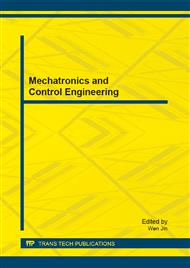[1]
A. E.Visser, R. P.Swatloski, K. D. Rogers, Vol, 39 (2000) 3596.
Google Scholar
[2]
J. G. Huddlesto, A. E. Visser, W. M. Reichert, H. D. Willauer, G. A. Broker, R. D. Rogers, Green Chem. Vol, 3 (2001) 156.
Google Scholar
[3]
K. N. Marsh, J. A. Boxall, R. Lichtenthaler, Fluid Phase Equilib. Vol, 219 (2004) 93.
Google Scholar
[4]
V. D. Sergei, R. A. J. Bartsch, Heterocycl. Chem. Vol, 38 (2001) 265.
Google Scholar
[5]
A. K. Abdul-Sada, K. R. Seddon, Eur. Mass Spectrom. Vol, 3 (1997) 245.
Google Scholar
[6]
R. M. Bell, M. G. Del Pópolo, T. G. Youngs, J. Kohanoff, C. G. Hanke, B. Harper, C. C. Pinilla. Acc. Chem. Res. Vol, 40 (2007) 1138.
DOI: 10.1021/ar700065s
Google Scholar
[7]
W. S. Miao, T. H. Chan. Acc. Chem. Res. Vol, 39 (2006) 897.
Google Scholar
[8]
X. X. Han, D. W. Armstrong. Acc. Chem. Res. Vol, 40 (2007) 1079.
Google Scholar
[9]
A. A. H. Pádua, M. F. C. Gomes, J. N. A. C. Lopes. Acc. Chem. Res. Vol, 40 (2007) 1087.
Google Scholar
[10]
E. J. Maginn. Acc. Chem. Res. Vol, 40 (2007) 1200.
Google Scholar
[11]
Y. Shim, D. Jeong, S. Manjari, M. Y. Choi, H. J. Kim. Acc. Chem.Res. Vol, 40 (2007) 1130.
Google Scholar
[12]
L. P. N. Rebelo, J. N. C. Lopes, M. S. S. Esperan, H. J. Guedes. Acc. Chem. Res. Vol, 40 (2007) 1114.
Google Scholar
[13]
C. Hardacre, J. D. Holbrey, M. Nieuwenhuyzen, T. G. A. Youngs. Acc. Chem. Res. Vol, 40 (2007) 1146.
DOI: 10.1021/ar700068x
Google Scholar
[14]
J. D. Aiken, R. G. Finke. Chem. Soc. Vol, 121 (1999) 8803.
Google Scholar
[15]
J. Dupont, G. S. Fonseca, A. P. Umpierre, P. F. P. Fichtner, S. R. J. Teixeira. Chem. Soc. Vol, 124 (2002) 4228.
Google Scholar
[16]
G. S. Fonseca, A. P. Fonseca, S. R. Teixeira, J. Dupont. Chem. Eur.J. Vol, 9 (2003) 3263.
Google Scholar
[17]
S. Vukojevic, O. Trapp, J. Grunwaldt, C. Kiener, F Schüth. Chem. Int. Ed., Vol, 44 (2005) 7978.
Google Scholar
[18]
M. Avalos, R. Babiano, P. Cintas, J. L. Jiménez, J. C. Palacios. Chem. Int. Ed. Vol, 45 (2006) 3904.
DOI: 10.1002/anie.200504285
Google Scholar
[19]
G. H. Tao, L. He, W. S. Liu, L. Xu, W. Xiong, T. Wang, Y. Kou, Green Chem. Vol, 8 (2006) 639.
Google Scholar
[20]
K. Fukumoto, M. Yoshizawa, H. J. Ohno. Chem. Soc. Vol, 127 (2005) 2398.
Google Scholar


